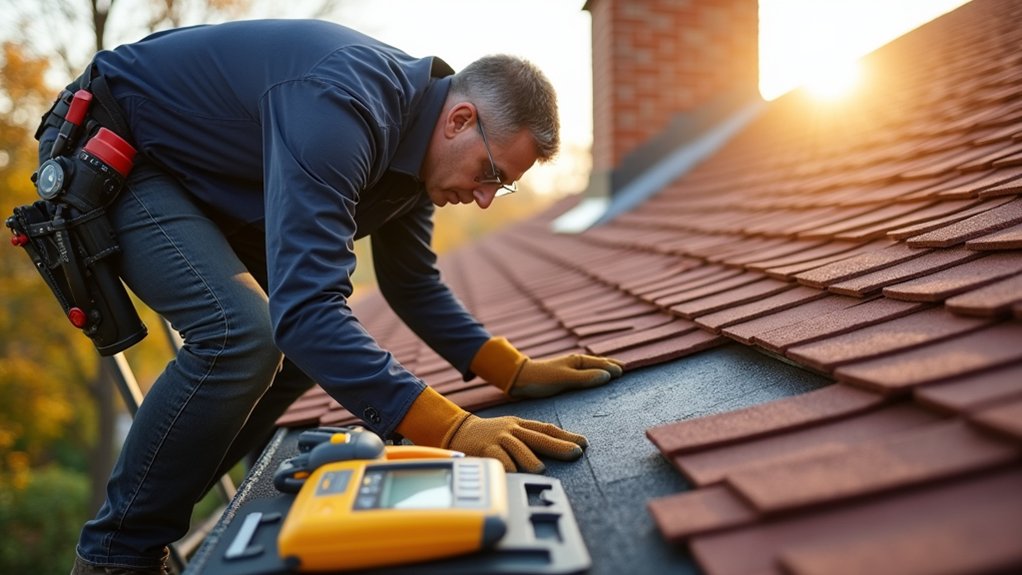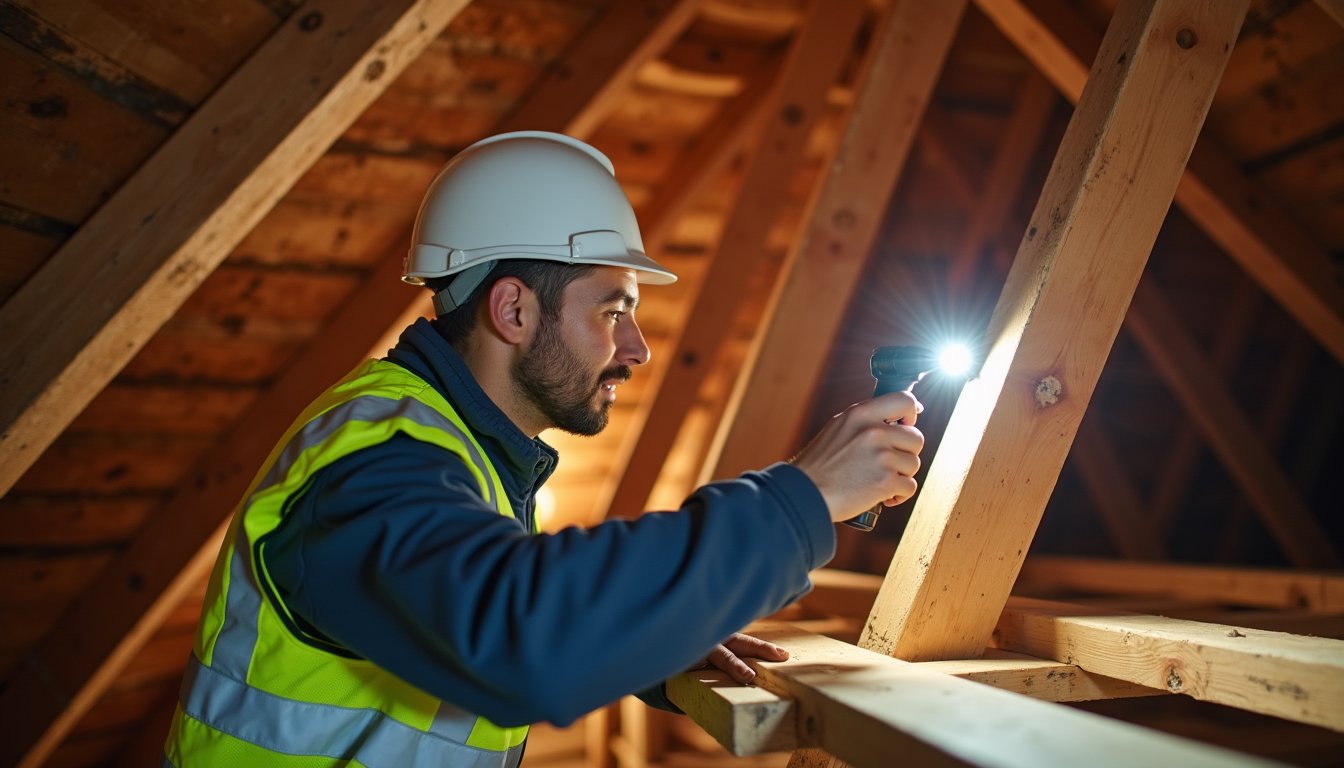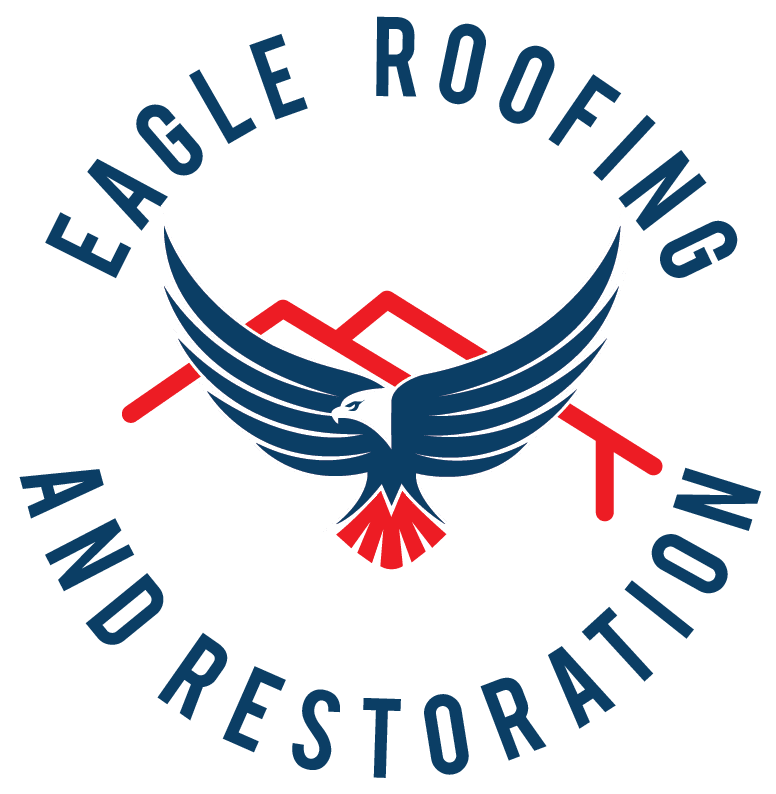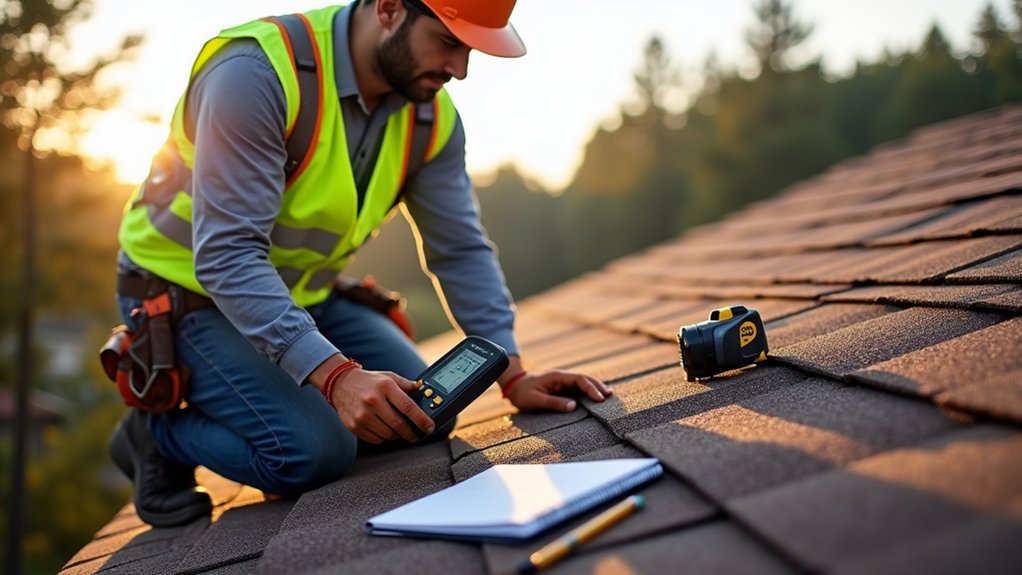Professional roof inspectors will examine five key areas during your inspection: structural components, roofing materials, interior conditions, ventilation systems, and safety elements. They’ll assess your roof deck, rafters, and trusses for weakness, check shingles and flashing for damage, look for water infiltration and mold growth inside, evaluate ventilation effectiveness, and verify all penetrations are properly sealed. Understanding these inspection points will help you better prepare for your upcoming evaluation.
Essential Components of a Professional Roof Assessment

Three core aspects define a thorough professional roof assessment: structural evaluation, component inspection, and workmanship analysis.
During your roof inspection, professionals will examine structural integrity by checking the framework’s condition, including roof deck, rafters, and trusses. They’ll identify signs of sagging, moisture intrusion, or deterioration that could compromise your home’s safety. The assessment includes a detailed review of all roof components, from shingles and flashing to gutters and vents, documenting any visible damage or wear.
Your inspector will evaluate the quality of roofing materials and installation techniques, noting issues like improper nailing or incorrect shingle placement. This exhaustive professional assessment culminates in a detailed report of your roof condition, complete with specific repair recommendations and replacement costs to help you make informed maintenance decisions.
Exterior Roofing Elements Under Inspection
During your roof inspection, you’ll find professionals thoroughly examining three critical exterior components that protect your home from water damage. Your inspector will check all flashing and metal elements around chimneys and vents, assess individual shingles for signs of deterioration or displacement, and verify the structural integrity of your gutter system. These exterior elements work together as your roof’s first line of defense, making their proper function essential for maintaining your home’s weatherproof barrier.
Flashing and Metal Components
Professional roof inspectors pay particular attention to flashing and metal components, as these critical elements serve as the first line of defense against water infiltration. During your roof inspection, they’ll examine the metal flashing around chimneys, vents, and other penetrations for signs of damage, rust, or improper installation that could compromise your roof’s integrity.
Your inspector will specifically assess counter flashing, step flashing, and drip edge conditions to guarantee they’re effectively directing water away from vulnerable areas. They’ll identify any missing, detached, or improperly installed components that could allow water penetration. If the professional roof inspector discovers compromised metal elements, they’ll recommend immediate replacement to maintain your roof’s water-shedding capability. Proper installation and condition of these components are essential for preventing costly water damage and preserving your roof’s long-term performance.
Shingle Condition Assessment
A thorough shingle inspection zeroes in on vital indicators of your roof’s health and durability. During roofing inspections, professionals carefully assess signs of damage to your roof, focusing on missing shingles, curling edges, and potential water infiltration points. They’ll examine your roof’s condition for any signs of sagging or deterioration that might require immediate roof repairs.
| Area Inspected | Warning Signs | Action Needed |
|---|---|---|
| Shingle Surface | Blistering, Curling | Replacement |
| Fasteners | Loose, Missing Nails | Reattachment |
| Valleys & Edges | Wear, Separation | Reinforcement |
Your roofing professional will pay special attention to vulnerable areas where roofing issues commonly develop, such as valleys and edges. They’ll evaluate the uniformity of shingle placement and check for proper sealing to prevent future complications.
Gutter System Integrity
Your gutter system serves as the roof’s primary defense against water damage, making its inspection a critical component of professional roof assessments. During the examination, inspectors methodically evaluate your gutters’ alignment and structural integrity, looking for signs of sagging that could lead to water backup and subsequent roof damage.
Professional inspectors thoroughly assess gutter connections and hangers to verify secure attachment to your home’s fascia. They’ll check for rust, corrosion, or holes that might compromise the system’s functionality. Your downspouts receive particular attention, as they must properly direct water away from your home’s foundation to prevent water infiltration. The inspection guarantees your entire gutter system effectively channels rainwater away from your roof and exterior walls, protecting your home from moisture-related complications that could lead to costly repairs.
Interior Examination Points and Warning Signs
While roof damage is often visible from the exterior, thorough interior inspections reveal pivotal warning signs that might otherwise go unnoticed. During these checks, inspectors carefully examine your ceiling space and attic space for water damage and leaks that can indicate serious roofing issues. They’ll search for telltale signs of mold growth and rot, which directly compromise your roof’s structural integrity.
Your roof insulation and underlayment will be evaluated to confirm they’re providing adequate protection. The inspection also includes a thorough assessment of ventilation problems that could affect your home’s air quality and energy efficiency. Inspectors will examine the structural integrity of all framing components, including trusses and rafters, looking for concerning signs of sagging or deterioration that require immediate attention.
Key Structural Areas That Require Expert Review

Professional roof inspectors focus on several specific structural components that form the backbone of your roofing system. During a proper roof inspection, they’ll systematically examine your roof’s deck and framework for any signs of structural weakness, sagging, or deterioration that could indicate potential problems.
A roofing contractor will pay particular attention to the critical connection points where different components meet. They’ll look at how your roof and attic space work together, checking the integrity of rafters, trusses, and support beams. The need for professional roof inspection becomes clear when inspectors evaluate the quality of workmanship, including nail placement and material selection. If significant issues are found, they’ll determine whether repairs will suffice or if a complete roof replacement is necessary to maintain your home’s structural integrity.
Critical Safety and Performance Indicators
During essential roof inspections, safety and performance indicators serve as pivotal benchmarks for evaluating your roof’s overall condition. Certified Home Inspectors conduct thorough roof inspections to identify critical signs of damage that could compromise your home’s integrity. Professional roof inspectors carefully examine roofs structural components, checking for sagging, deterioration, and potential failure points.
Your Roofing Companies’ experts assess crucial elements like Pipe Boots, flashing, and ventilation systems to guarantee proper functionality. During regular roof inspections, roofing contractors look for water damage, mold growth, and pest infestations that might weaken your roof’s protective capabilities. They’ll also verify that all components meet current building codes and safety standards. This systematic evaluation helps identify issues before they escalate into costly repairs or dangerous situations.
Maintenance Requirements Identified During Inspection

An effective roof inspection reveals specific maintenance requirements that safeguard your home’s structural integrity and longevity. During a basic roof inspection, your inspector will examine both exterior and interior elements to address any potential issues before they escalate into major problems.
You’ll receive specific guidance on whether to repair or replace worn shingles, seal compromised flashing, and clear clogged gutters. The condition of your roof’s underlayment, structural components, and ventilation system will determine the urgency of maintenance needs. Your inspector will identify problems early, which can help maintain your homeowners insurance coverage and prevent costly damages. When you schedule a roof inspection, they’ll also assess critical elements like chimneys, vents, and skylights, ensuring all roof penetrations are properly sealed and functioning.
Frequently Asked Questions
What Is Checked During a Roof Inspection?
During a roof inspection, you’ll have professionals assess your roof material condition, surface abrasion, and structural stability. They’ll examine your roof ventilation systems and insulation quality while checking drainage efficiency through gutters and downspouts. They’ll evaluate roof flashing integrity around chimneys and valleys, plus verify all penetration seals are intact. They’ll also guarantee there’s proper roof accessibility for maintenance. This thorough check helps prevent future issues.
How Does a Roof Fail Inspection?
Your roof can fail inspection if there are multiple critical issues present. You’ll face failure if inspectors find significant roof leaks and damage, poor roof material condition, or compromised structural integrity. Inadequate roof ventilation issues, damaged flashing, improper roof pitch and slope, or excessive debris accumulation can also lead to failure. Additionally, your roof age, surface imperfections, and roof drainage concerns that aren’t properly addressed will result in inspection failure.
What Is a 21 Point Roof Inspection?
A 21-point roof inspection is your thorough roofing assessment that includes essential checkpoints to evaluate your roof’s integrity. You’ll receive detailed evaluations of roof slope measurement, material condition, and ventilation systems. The inspection covers flashing integrity, drainage functionality, and sealing effectiveness. Your inspector will examine roof penetrations, insulation quality, and underlayment condition. They’ll also verify warranty status and document all findings in a detailed report for your records.
What to Look for When Inspecting a New Roof?
When inspecting your new roof, you’ll need to evaluate several critical components. Start with the roof material condition and proper pitch evaluation. Check roof ventilation assessment and guarantee all flashing installations are secure. Review roof penetrations like vents and chimneys for proper sealing. You’ll want to verify roof code compliance and assess insulation effectiveness. Don’t forget to examine debris removal needs and determine if immediate cleaning is necessary.

